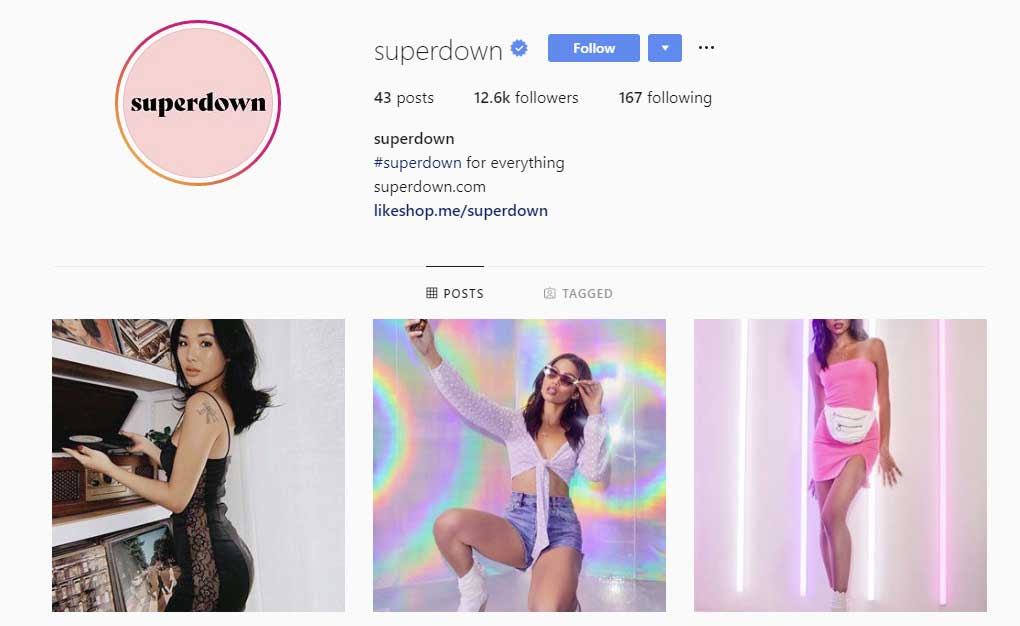First published on
Most Instagram users will be at least somewhat familiar with the fashion brand Revolve.
The company has successfully used celebrities and mega influencers to boost brand awareness, and turn the label into a billion dollar success. Revolve attributes its influencer marketing strategy with bringing in as much as $650 million to $700 million in revenue a year – and now, it’s looking to take that approach to the next level, with the launch of a new, Gen Z focused label called Superdown.
Revolve’s approach through Superdown is to cater more directly to the needs to the next generation of consumers – most notably through more accessible price points and, of course, influencer activation.

The strategy is representative of a wider shift in the industry, with an increasing number of brands adapting their products and marketing strategies to cater to this emerging consumer cohort. True digital natives, with limited patience and attention spans, Gen Z is the next frontier for marketers – and with the eldest turning 22 this year, and their spending power already estimated between $29 and $143 billion, understanding their behaviour is fast becoming essential for those brands that want to capture and maintain their attention.
Here’s a look at the behaviours which have lead to brands like Revolve honing their strategies for this demographic.
They are habitual multi-screeners
Whether they’re scrolling Instagram with one eye still on Netflix, or using their iPad to shop, Gen Z has grown up with cell phones in their hands, and they are highly adept at multitasking.
With their attention split across devices, converting them into a captive audience presents a challenge – but some brands have managed to use this behaviour to their advantage. Last year in the UK, fast fashion retailer Missguided partnered with the wildly popular reality TV show ‘Love Island’ to dress participants in their clothing. Viewers could see their favourite personalities on screen, in an outfit that was instantly available for them to shop as they watched. The brand saw a 40% uplift in sales as a result.
Understanding, and utilising such behaviours to advantage is key – yes, it means that these younger audiences are not always a captive audience on any single platform as some may have been in the past, but the brands that can adapt to this, and think of new, innovative, and collaborative ways to tap into such stand to win out.

Social media is life
With 75% of Gen Zers naming the mobile phone their device of choice – and the majority spending around three hours per day on social media – a mobile-first marketing strategy is essential.
Instagram’s steps towards eCommerce provide a big opportunity here. Shopping tags in images and the “swipe up” option in Stories both tap into Gen Z’s expectation of instant information, and work to maximise their attention before it’s lost.
Now, the long-awaited “Checkout” on Instagram (launched in the US) looks set to take this to the next level – through Checkout, users will have the ability to make immediate purchases in-app. No link in bio, no redirection.
With less time, and more distractions than ever, this streamlined process caters to modern consumer behaviour. The function is currently only available to a select number of launch partners, so brands have some time to consider how they can maximise this opportunity.
They’re slow to trust
Access to 24/7 news coverage of turbulent global events – including terrorism, cyberattacks and security breaches – has shaped Gen Z’s attitude. They’re more cautious, and lack trust in large organisations, often including brands.
So how can marketers overcome this obstacle?
Transparency and responsiveness are important factors in getting this audience on your side. Offering them entertainment, help and advice will also win you favour. Criteo’s Gen Z report showed that 62% of Gen Z prefer ads which ‘bring value to their lives’. It’ll not only encourage them to spend more time with your content, but they’ll appreciate the fact that you’ve earned the right to advertise to them.
But with brands only representing 10% of Gen Z’s followed accounts, marketers can’t expect to gain access to their social circles on their own. Influencers can help bridge this gap – Gen Z looks to influencers as trusted peers: They are 1.3x more likely to purchase a product recommended by an influencer than by a traditional TV or movie celebrity. Influencers also tap into their cautious reliance on reviews – 78% of Gen Z has read a review when buying a product in the past 30 days.
Despite their lack of trust, Gen Z are open to being advertised to. A study found they were more likely to buy a product after watching a social ad than a Millennial – so the outlook is far from gloomy. The secret lies in acknowledging their differences in behaviours, priorities, and values, and adapting your strategy accordingly.


